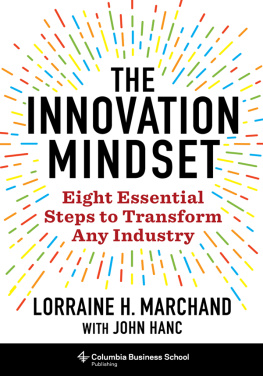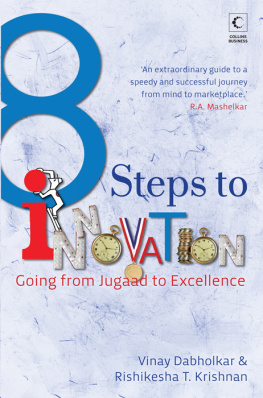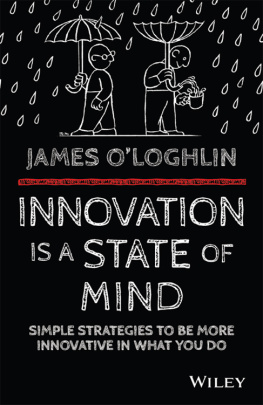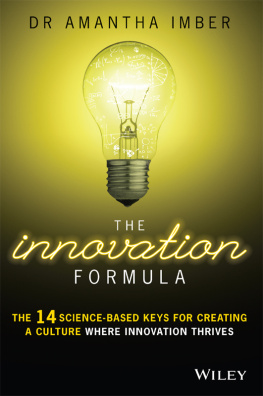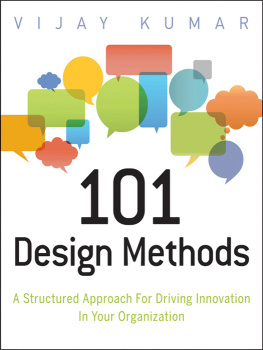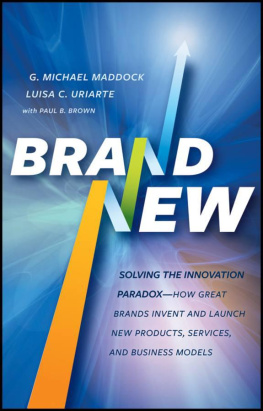Table of Contents
Praise for The Innovation Mindset
Innovate or die is my mantra as an expert in marketing strategies for new technologies. Marchand is one of the most skillful innovators and communicators Ive had the pleasure of working with. Her approach works, and Ive experienced it firsthand. Her book should be required reading for students and corporate executives alike who are striving to stay relevant in a dynamic business environment.
Joanne Moretti, founder and CEO, JCurve Digital; former chief marketing officer, Jabil; and former executive at Hewlett-Packard, Dell Technologies
The ability to generate new ideas, products, and services is the key determinant for success in almost every twenty-first-century industry, which is why The Innovation Mindset by Lorraine H. Marchand is so timely and so important. Hers is unquestionably one of the most effective methods for fostering a culture of change in your organization. If youre not already an innovator, you will be inspired to become one after reading this book!
Jabril Bensedrine, CEO, SESA Systems; the Triana Group; and professor of entrepreneurship and innovation, Tandon School of Engineering, New York University
The Innovation Mindset is a practical guide with case studies examining how we approach issues and how we can benefit from understanding best practices in implementing an innovative mindset in our everyday worldsomething you can apply in all aspects of your life.
Amit Rakhit, MD, chief executive officer, Sporos Bioventures; former president and chief medical officer, Ovid Therapeutics; and former medical officer, Biogen, Bristol-Myers Squibb
In her inspiring and enjoyable book filled with case studies, personal stories, and insightful anecdotes, Marchand demystifies the term innovation and provides practical steps to stimulate creativity and new product development within organizations. The Innovation Mindset provides a framework and tools to foster creativity for seasoned executives and first-time entrepreneurs alike.
Tracy Harmon Blumenfeld, cofounder and CEO, RapidTrials
The Innovation Mindset
Columbia University Press
Publishers Since 1893
New YorkChichester, West Sussex
cup.columbia.edu
Copyright 2022 Columbia University Press
All rights reserved
EISBN 978-0-231-55486-2
Library of Congress Cataloging-in-Publication Data
Names: Marchand, Lorraine Hudson, author. | Hanc, John, author.
Title: The innovation mindset: eight essential steps to transform
any industry / Lorraine Hudson Marchand with John Hanc.
Description: New York: Columbia University Press, [2022] | Includes index.
Identifiers: LCCN 2021053902 | ISBN 9780231203081 (hardback) |
ISBN 9780231554862 (ebook)
Subjects: LCSH: Product design. | Product management. |
Technological innovationsEconomic aspects.
Classification: LCC HF5415.153 .M3378 2022 |
DDC 658.5/75dc23/eng/20211109
LC record available at https://lccn.loc.gov/2021053902
A Columbia University Press E-book.
CUP would be pleased to hear about your reading experience with this e-book at .
Cover design: Noah Arlow
To Dad, an original thinker, who showed me how
problems are opportunities waiting to be created.
To my sons, Joe, Nick, and Matt,
You possess innovator DNAcuriosity, creativity,
and resilience. Stay alert and your heart and
head will reveal opportunities to put it to use
for good.
Contents
Spencer Rascoff
W hat Lorraine Marchand has written in this book is nothing short of, well, innovative. The detailed road map that follows, packed with engaging anecdotes and practical planning processes from companies of every size and scale, will provide any individual or team the tools needed to create the perfect environment for innovation. Discussing notables and novices alike, Lorraines examples and commentaries are relevant and fascinating.
Lorraine is a dynamic force, writing on a subject that she not only espouses but embodies herself. As the GM of Life Sciences for IBMs Watson Health, a strategist for big pharma, a repeat start-up founder, a director at NIH, and a professor at Columbia Business School, she has a breadth of experience and insights that have empowered her to innovate and pivot throughout her career, just as she guides businesses to do.
She will equip readers to ideate unique start-ups, learn comprehensive steps for customer research and advancement, and be inspired to foster innovation throughout every stage of a companys growth. The examples and actionable techniques laid out in the following pages will set up innovators of any age for successand would have been a welcome tool in my own arsenal when I began my professional career.
Ive had the good fortune to be involved in a number of inventive companiescompanies such as Hotwire, Zillow, and Pacasothat successfully disrupted massive sectors of the economy, including travel, real estate, and the vacation-home market. Im also an angel investor and have invested in more than one hundred start-ups.
Lorraines Laws of Innovation are right on. In fact, I give similar advice to my portfolio companies and use some of her laws to determine where to invest.
First, Lorraine says that a successful innovation must offer a solution. I agree with this completely. This was the case for my three successful companies. Hotwire, founded in 2000, changed the way people booked travel. Internet-assisted travel booking was still new, and hotels and airlines were changing the way they thought about inventory and distribution. Consumers, too, had few options for booking at that time. We created Hotwire to solve both those problemsand twenty-two years later, the brand is still going strong.
I agree with this law of innovation so much that it is one of my criteria for investment. If a company cant easily define a problem for meand show me they are solving itI wont invest.
Ive also had deep experience with Law 4 (one hundred customers cant be wrong) and Law 5 (be ready to pivot at any point in the process).
At Zillow, a key to our success was always listening to customers. Lorraine is a proponent of one hundred interviewstalking to people of different demographics but all prospective customers. This is critical, and such practices formed the brand and foundation of all of my companies. At Zillow, this practice was continual. We talked to customers constantlyin an annual survey of thousands of home buyers, sellers, renters, and owners; in one-on-one interviews and small focus groups; and on social media. Those insights formed the basis for ongoing product and marketing decisions and are a key to any companys successbig or small.
Ive also seen the pivot, or 3-P, law in actionand this can be the toughest one for a start-up founder or a leader of a mature company. When we launched Zillow in 2006 it was merely a voyeuristic toy, a way to bring information transparency to real estate. But through product innovation and acquisitions, we expanded Zillow into new businesses such as rentals, mortgages, and title and escrow. We also morphed from a media business that was dependent upon advertising into a transactional business that helped people complete real estate transactions. There were pivots, and unpivots, and repivots along the way. But as we navigated these advances, we followed consumer preferences and grew the company enormously.

